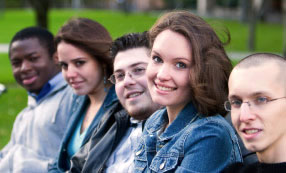|
What is Peer Review and Why is it Important?
From Research Study to Knowledge: The Process of Peer Review
Research is the foundation of modern Science. Much of what we know is a product of scientific research. But how does research become knowledge? How does research move from the "doing phase" to the "accepted knowledge phase"?
Research is a process. Research is designed, conducted and documented. Before it is accepted by the scientific community (and then practitioners) the research must be shared with the scientific community and gain acceptance in the scientific community. Communicating results with members of the scientific community is central to how we move from "doing research" to "accepted knowledge." Research needs to be shared and then accepted by fellow scientists to be considered credible.
Peer review is a form of quality assurance or "certification." Peer review is having someone or several people in the field -- outside of anyone involved in the research -- double check the work and provide assurance that the research meets field-accepted standards of scientific quality.
Peer reviewers scrutinize the work, accept it, reject it, pose questions, or ask for more information before it is printed in a journal or presented at a professional conference to help ensure that that the paper is "sound." There are several ways in which this is done, but most often the paper is reviewed by two, three, or more scientific peers to "put a stamp of approval" on the research.
Peer reviewers validate the research, and provide a trusted source of communication to the research community and practitioners. The goal is to help other members of the community (even if they are not familiar with the product or technology) trust in the conclusions presented.
Ideally, reviewers should be familiar with the expectations of the field, and know how
the research should be conducted and described. They are expected to know what meets scientific standards. They are entrusted with the job of allowing only qualified work to hold the title of "peer reviewed" and be presented or published.

Steps involved in gaining peer review acceptance:
-
Scientists complete a study and write it up in the form of an article.
-
It is submitted to a journal or conference for publication.
-
An editor or conference program chair sends the article to other vetted scientists in the same field.
-
The reviewers provide feedback and inform the editor or conference programmer if they think the study is of high enough quality to be presented or published.
-
In some cases, particularly for journals, the submitting scientist may often be asked to revise the paper and resubmit it for consideration.
-
Only articles that meet scientific standards (such as logical reasoning and well-designed with evidence), are accepted for presentation or publication and secure peer review status.
As participants in the scientific community of educational researchers, SEG Measurement encourages peer review of our efficacy studies to ensure that they meet appropriate standards. Our commitment to peer review benefits our clients and their customers, by helping to ensure that the claims made are credible. Showing that the research has held up to scientific scrutiny, helps clients help gain product acceptance and helps customers make informed buying decisions.
For example, SEG recently submitted to papers for peer review, that were accepted and presented at the Association for the Advancement of
Computing in Education (AACE) EdMedia 2015 Conference, June 22-24, in Montreal, Canada:
We have only scratched the surface on this topic.If you would like to know more, please let us know. You can contact us at 257-759-0617 or email us at info@segmeasurement.com.
|
 SEGway
SEGway SEGway
SEGway